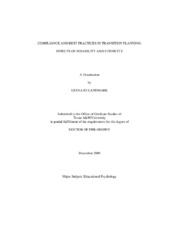| dc.description.abstract | It is well known that individuals with disabilities have poor postsecondary
outcomes. As a result, state and local education agencies are held accountable for the
post-school achievements of their students with disabilities. The purposes of this study
were (a) to determine the extent to which the transition components of Individualized
Education Program (IEP) documents were compliant with the transition requirements of
the Individuals with Disabilities Education Improvement Act of 2004 (IDEIA), (b) to
determine the extent to which the transition components of the IEP documents provided
evidence of best practices, (c) to determine the effects that disability category and
ethnicity had on compliance and practices as evidenced in the transition components of
the IEP documents, and (d) to determine the relationship between overall compliance
and best practices. The sample for the study included 212 secondary students who had a
developmental disability, an emotional disorder, or a learning disability and who were
African American, Caucasian, or Hispanic. Several types of analyses were conducted
including descriptive, multiple logistic regression, and Spearman's rho correlation.
The overall level of compliance was 2.03 (SD = 1.238). The range of possible
scores was 0 - 5, with 0 indicating that none of the components of compliance were
100 percent compliant, and 5 indicating that all of the components were 100 percent compliant. The
overall level of best practices as evidenced in the IEP documents was 4.89 (SD = 1.569).
The range of possible scores was 0 - 8, with 0 indicating that there was no evidence of
any of the practices in the IEP document, and 8 indicating that evidence of all the
practices was found in the IEP document. A student's disability category and ethnicity
were found to be influencing characteristics for increasing or decreasing the probability
of an IEP document being compliant and/or having evidence of best practices. A
statistically significant correlation of r = .429 was found between the overall levels of
compliance and best practices, indicating that as the level of compliance increased, so
too did the level of best practices evident in the IEP document. | en |


